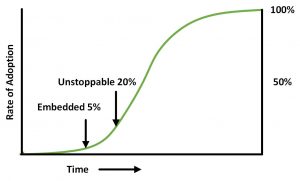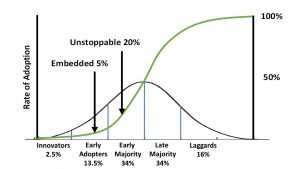Innovation Adoption Curve - Adopters versus Adoption
The process of adoption is affected by the individuals that are in the process of adoption. Understanding the Adopter Categories helps to explain the way adoption occurs.
Innovation Adopter Categories
 The literature divides an organization into five “adopter categories” that relate to the willingness and speed of the individuals to accommodate change. Interestingly, this breakout works for an individual organization or a collection of organizations. If you take a given population of organizations, the adopter categories work the same way as for individuals within a given organization.
The literature divides an organization into five “adopter categories” that relate to the willingness and speed of the individuals to accommodate change. Interestingly, this breakout works for an individual organization or a collection of organizations. If you take a given population of organizations, the adopter categories work the same way as for individuals within a given organization.
Goodness should not be assigned to any one of the categories, they are what they are and each brings benefits and challenges. The names, assigned in the literature, that are given relate to when they accommodate the change, not to their goodness. Under each of the names in the graphic is the dominant characteristic of the group. The curve is based on when organizations took on a change. It was applied to a normal distribution. The mean was identified and then first and second standard deviations. The individuals were then analyzed for their characteristics. The “Laggards” include the second and third standard deviations on the right side because the characteristics were essentially the same. For any given organization or collection, the distribution of of categories can vary, especially if there is a stress for certain characteristics in the population. Highly procedural operations may drive to the right. Highly technology based organizations may drive the the left. Or the distribution may be more relative than absolute in terms of the characteristics of the categories, e.g., an “Early Majority” in one industry may look like a “Laggard” in another. Let’s discuss the categories.
The different types are:
- Innovators Venturesome – Venturesome, looking to establish new ideas, tendency to have connections outside the organization
- Early Adaptors Respect– Go to people to identify how realistic the approach is. Also are the ones to diffuse the change
- Early Majority Deliberate – Typically not the first to adopt, but will adopt if the change looks promising. Not typically the leaders.
- Late Majority Skeptical – Will wait for the majority to adopt the change before proceeding.
- Laggards Traditional – Traditionalists, late adopters, do not want to be on the blame list.
By walking through a change process, we can see how understanding the existence of these groups can improve your chances of adopting change.
Innovation Adoption Curve
 As discussed in Everett M. Rogers’ Diffusion of Innovations Fifth Edition, the innovation adoption curve represents the rate of adoption of an innovation. Interestingly, this may be across an industry over time or in an individual organization. The difference will be the timeframe of the adoption. Obviously longer in an industry than an individual organization. Actually, for an industry, you will have mini-cycles for each organization in their adoption. The rates of speed will depend on many factors. Some organizations or industries are going to be much more aggressive than others. Culture and market forces are going to be major factors.
As discussed in Everett M. Rogers’ Diffusion of Innovations Fifth Edition, the innovation adoption curve represents the rate of adoption of an innovation. Interestingly, this may be across an industry over time or in an individual organization. The difference will be the timeframe of the adoption. Obviously longer in an industry than an individual organization. Actually, for an industry, you will have mini-cycles for each organization in their adoption. The rates of speed will depend on many factors. Some organizations or industries are going to be much more aggressive than others. Culture and market forces are going to be major factors.
Malcolm Gladwell discusses in his book The Tipping Point when change will permanently take in an organization. Basically, the understanding is that at 5%, the change is embedded. That is, the change is actively engaged in the organization. At 20%, it is unstoppable. The Early Adopters are on board and the Early Majority is beginning to take up the banner. Why these percentages?
Aligning the Adoption Curve to the Adopters
 If we superimpose the Adoption Curve onto the Adopter categories, you can see why the Adoption Curve develops as it does.
If we superimpose the Adoption Curve onto the Adopter categories, you can see why the Adoption Curve develops as it does.
Innovators begin to develop and institute the solutions. Early Adopters begin adopting the change and refine the processes. We are beginning to develop some momentum at 5% as the process begins to show some integrity. Early Adopters complete their adoption and the Early Majority (much larger numbers) are beginning to see the potential and the direction everything is going. We have now hit 50% and the Late Majority realizes this is happening and it is time to begin accommodating the change. Eventually, Laggards being the remaining 16%, end up falling in line or leaving.
What are the principal steps needed to make this work?
- Backing from Management – If Management is not prepared to wholly support the effort, adoption will be jeopardized
- Communications – This is also part of Management support. Letting the organization know what is going on and that they are behind it. Report the progress so the organization see there is a commitment and that obstacles are being overcome.
- Prototyping – providing models on which participants can try out the change and evaluate the impact.
- Pilot Programs – When possible, start with small groups who can apply the change to real life and evaluate it. As the change gains success, it will be easier for the Early Majority to get on board.
- Training Program/ Transition – Final success is really going to be dependent on the comfort the users achieve from the process. The smoother the better.
Understanding the different types of users with the proper progression and evolving a well-planned transition plan will have a lot to do with your success. There will be resistance, but as everyone sees a commitment to the change and the success of the progress, the organization will evolve.
